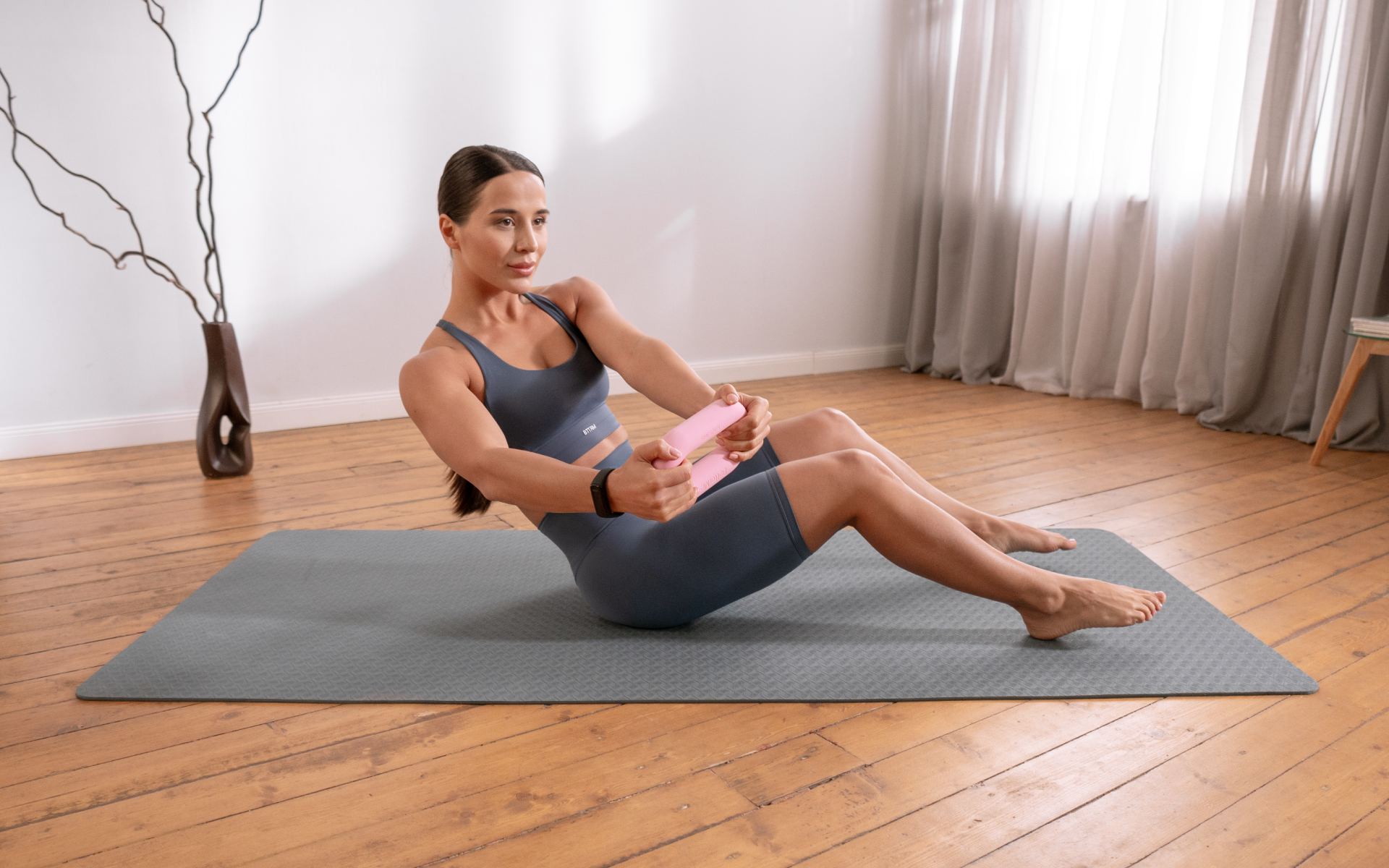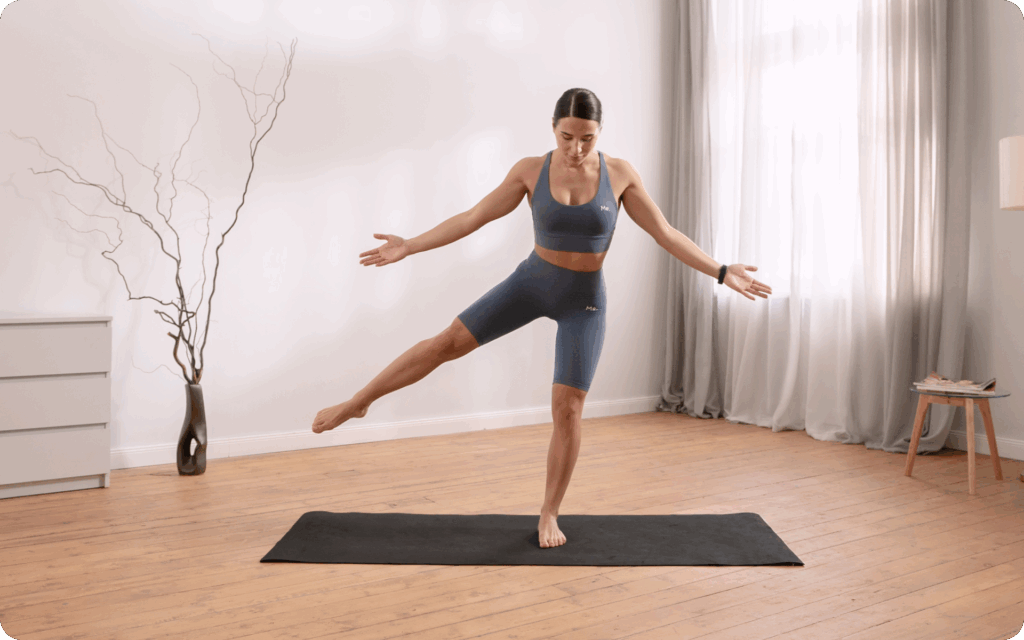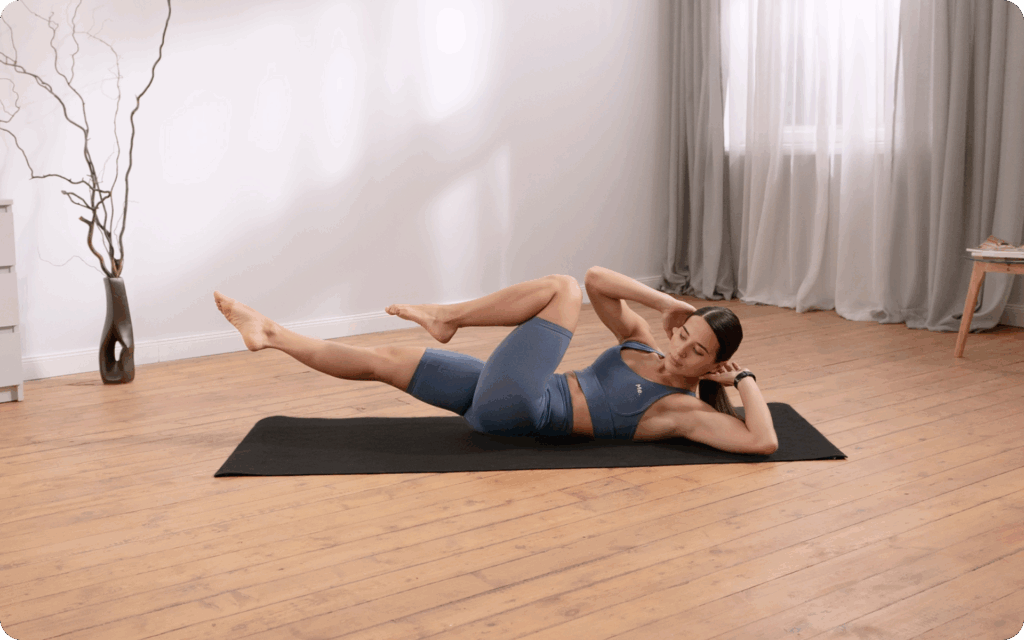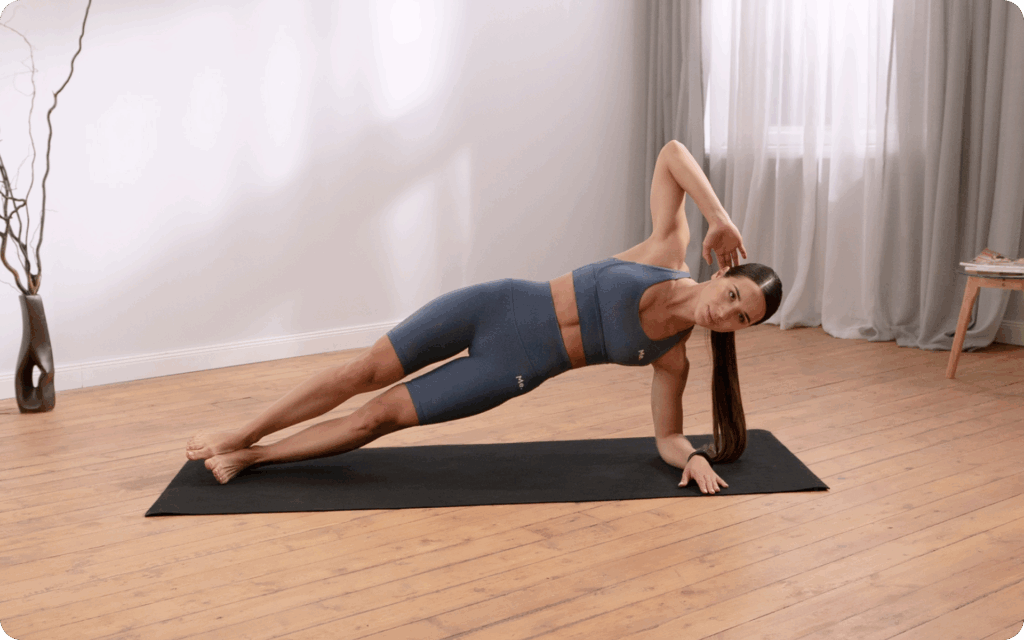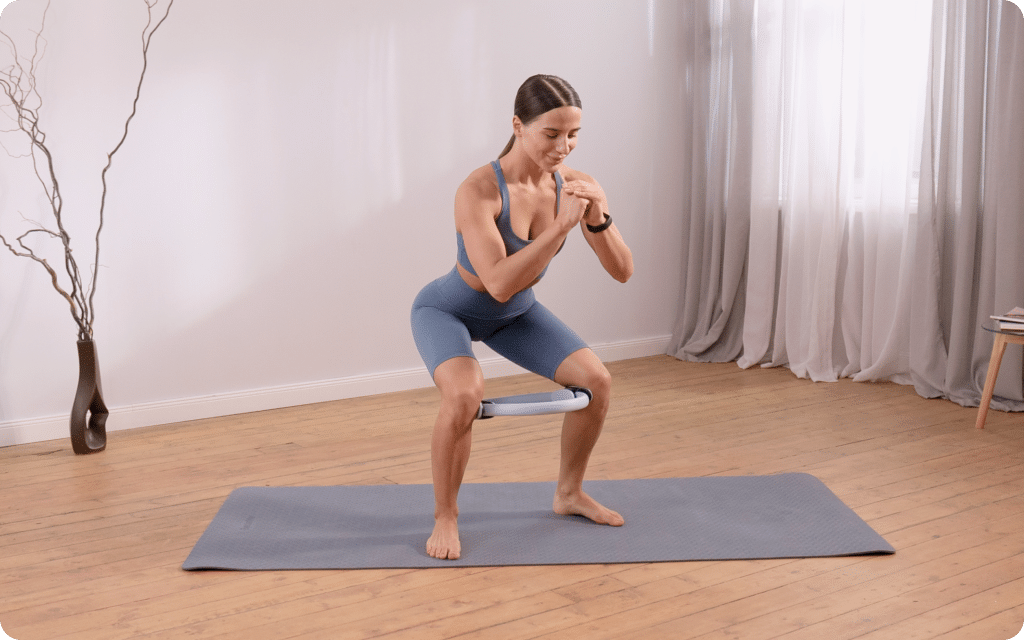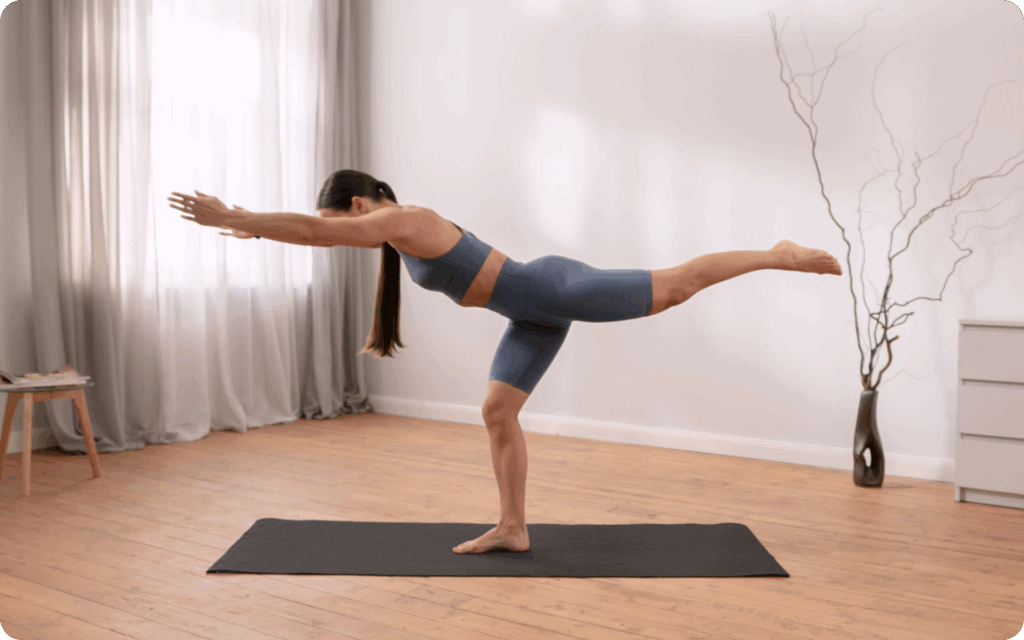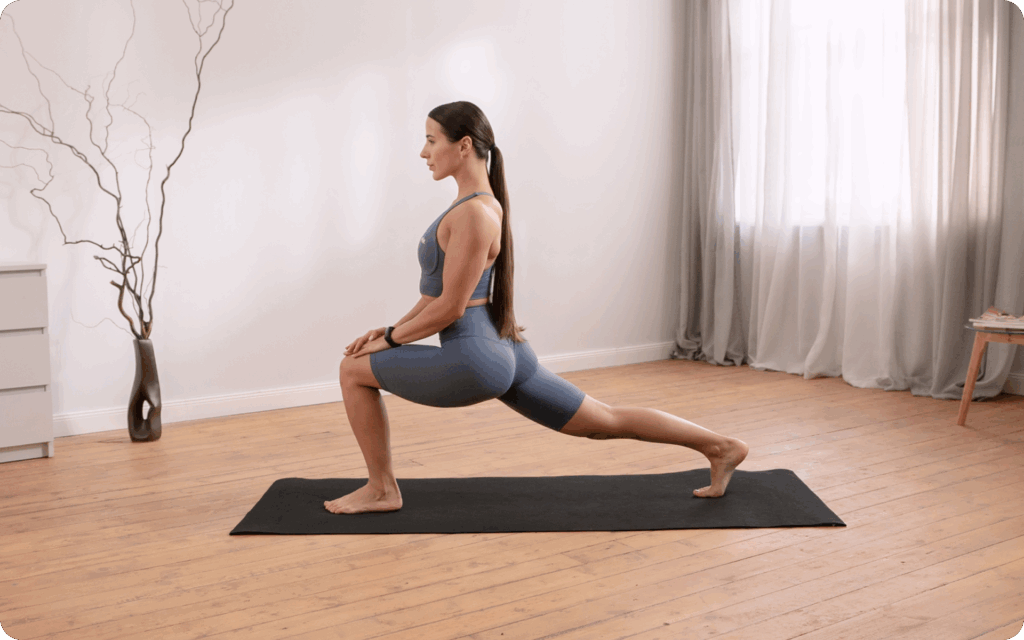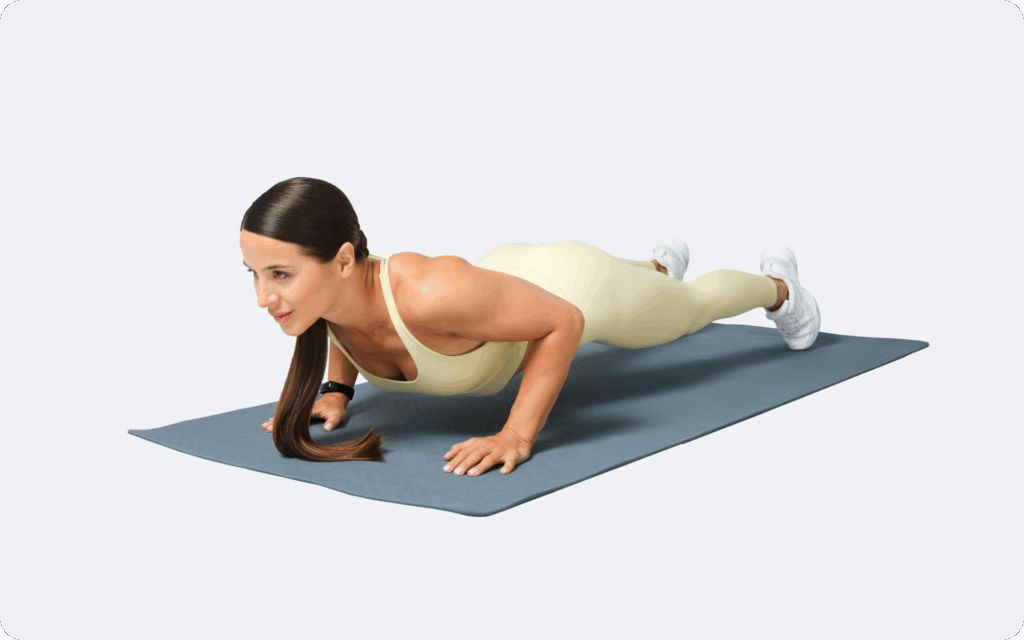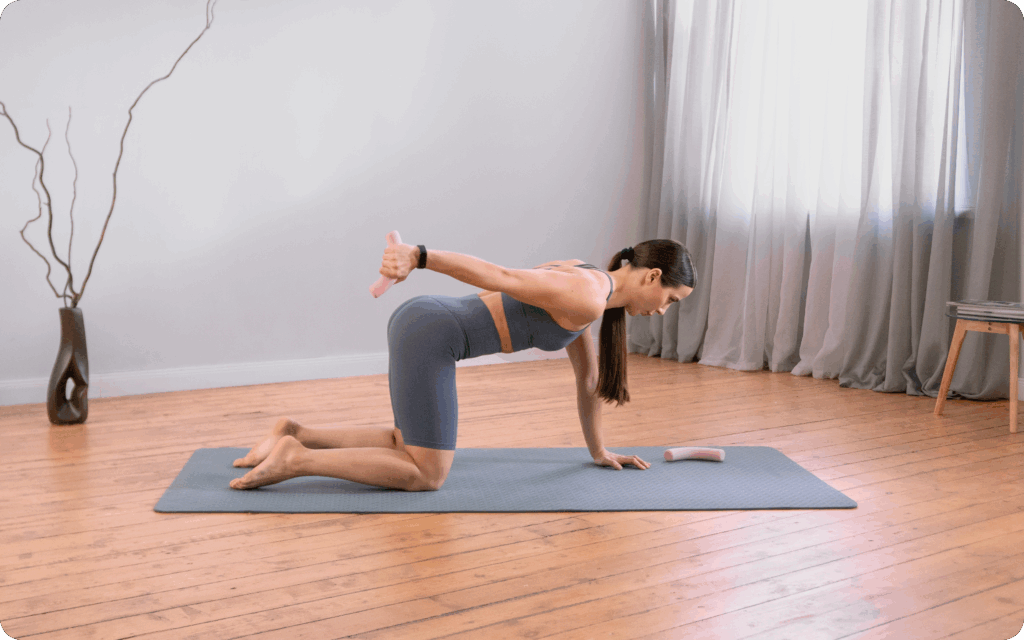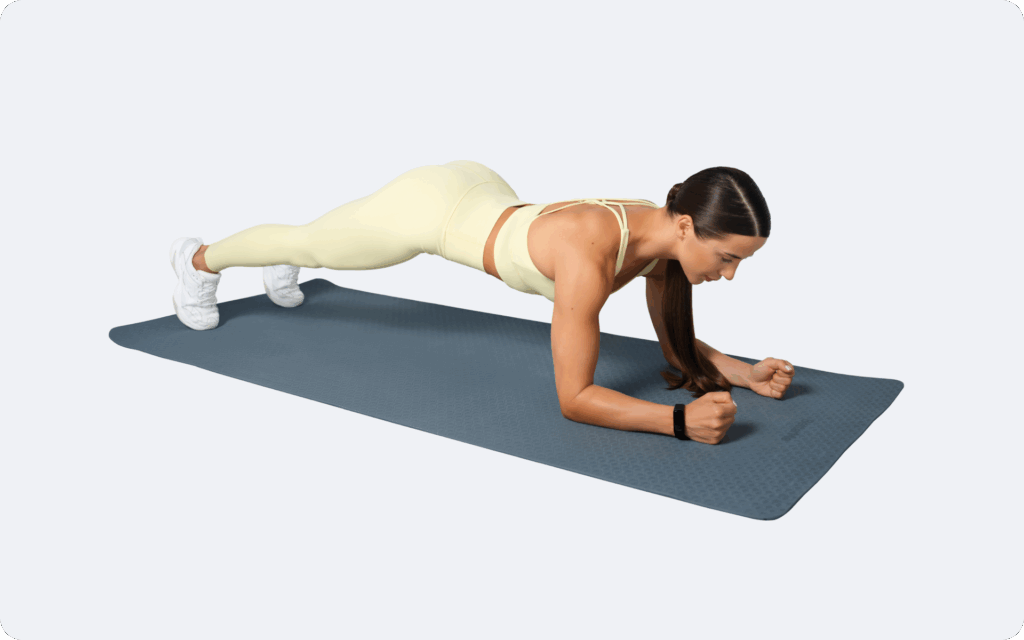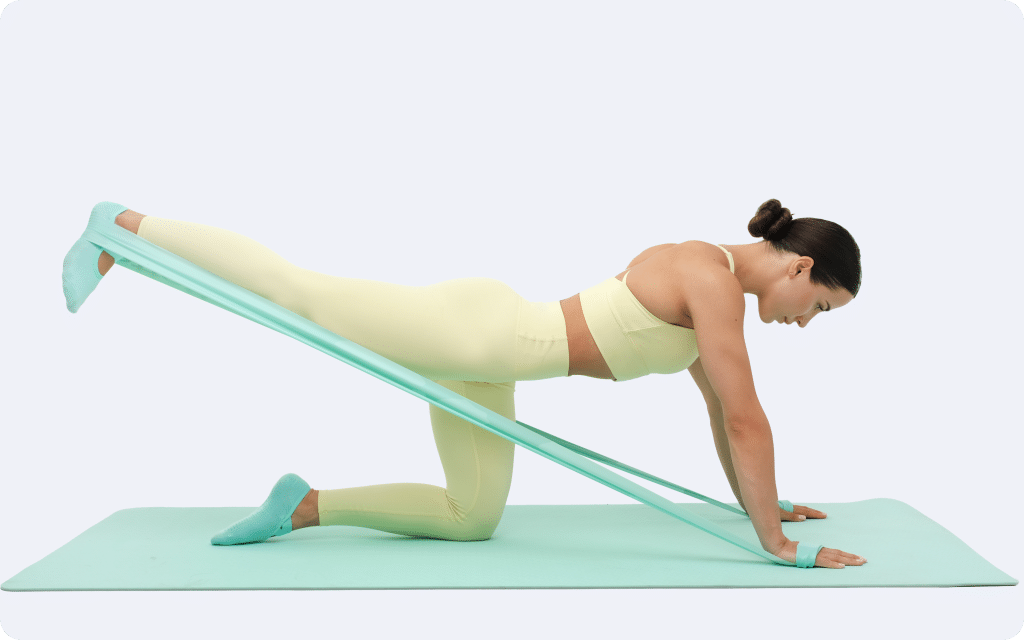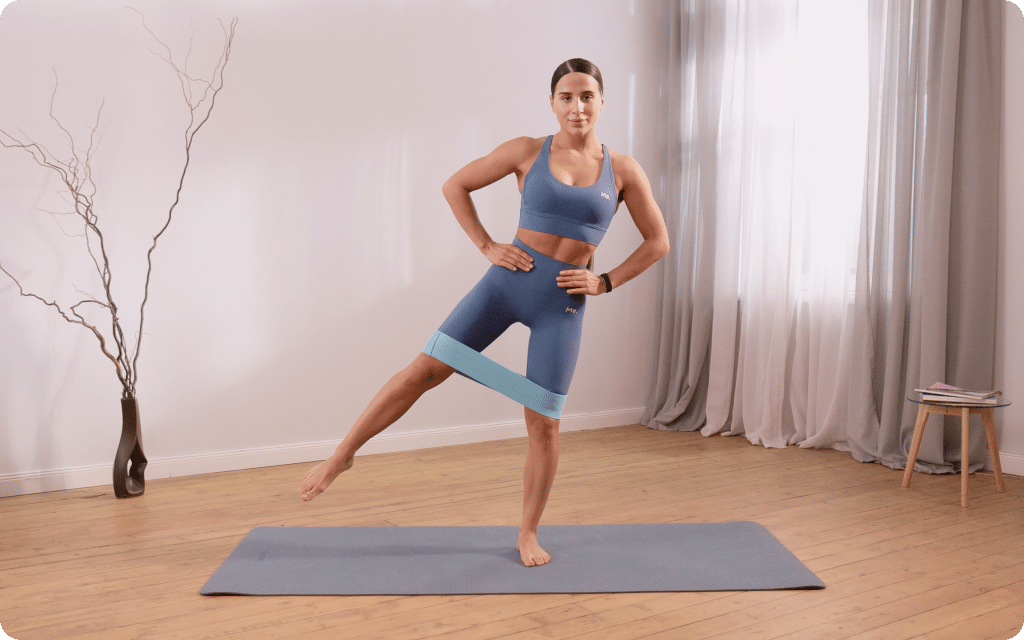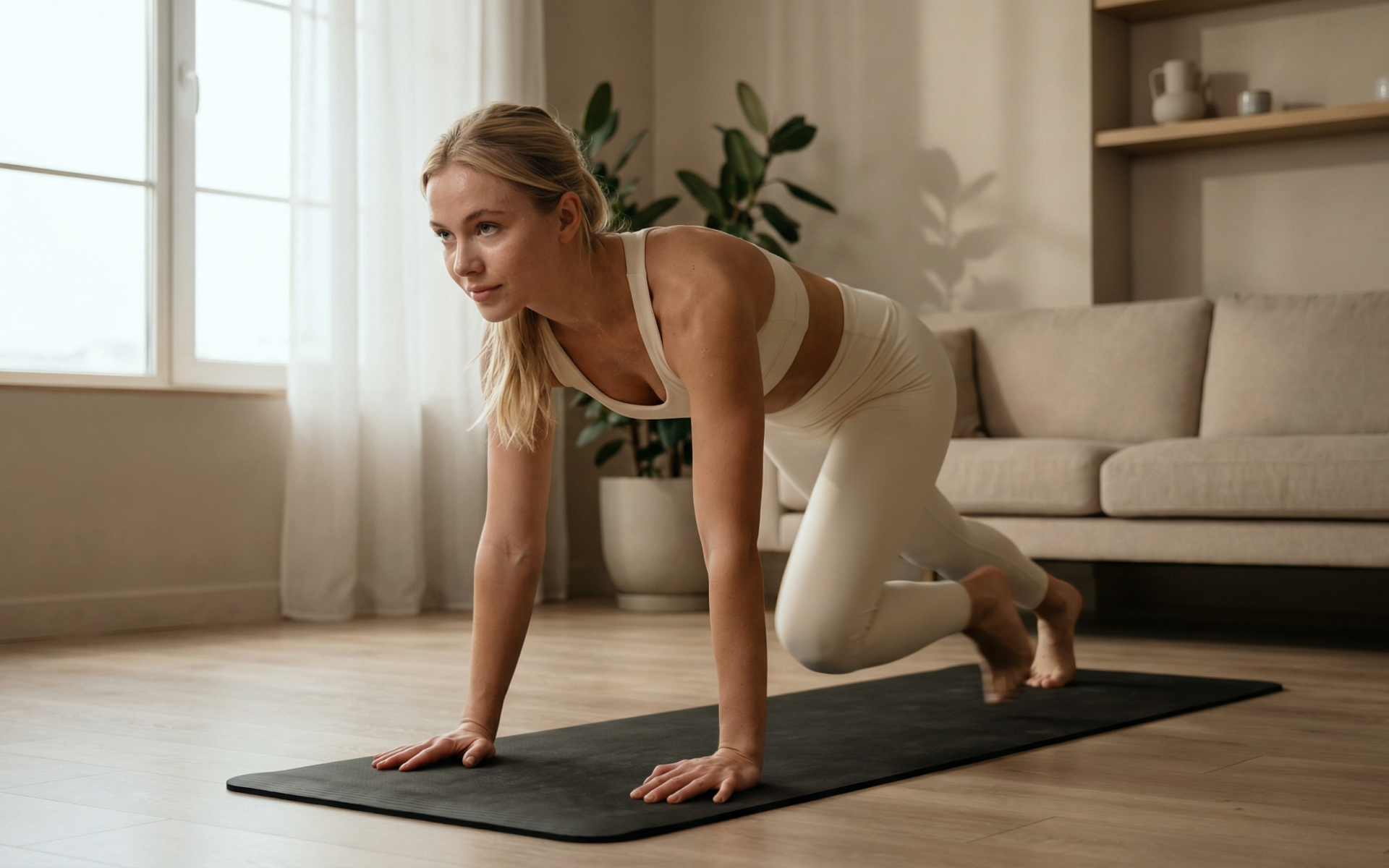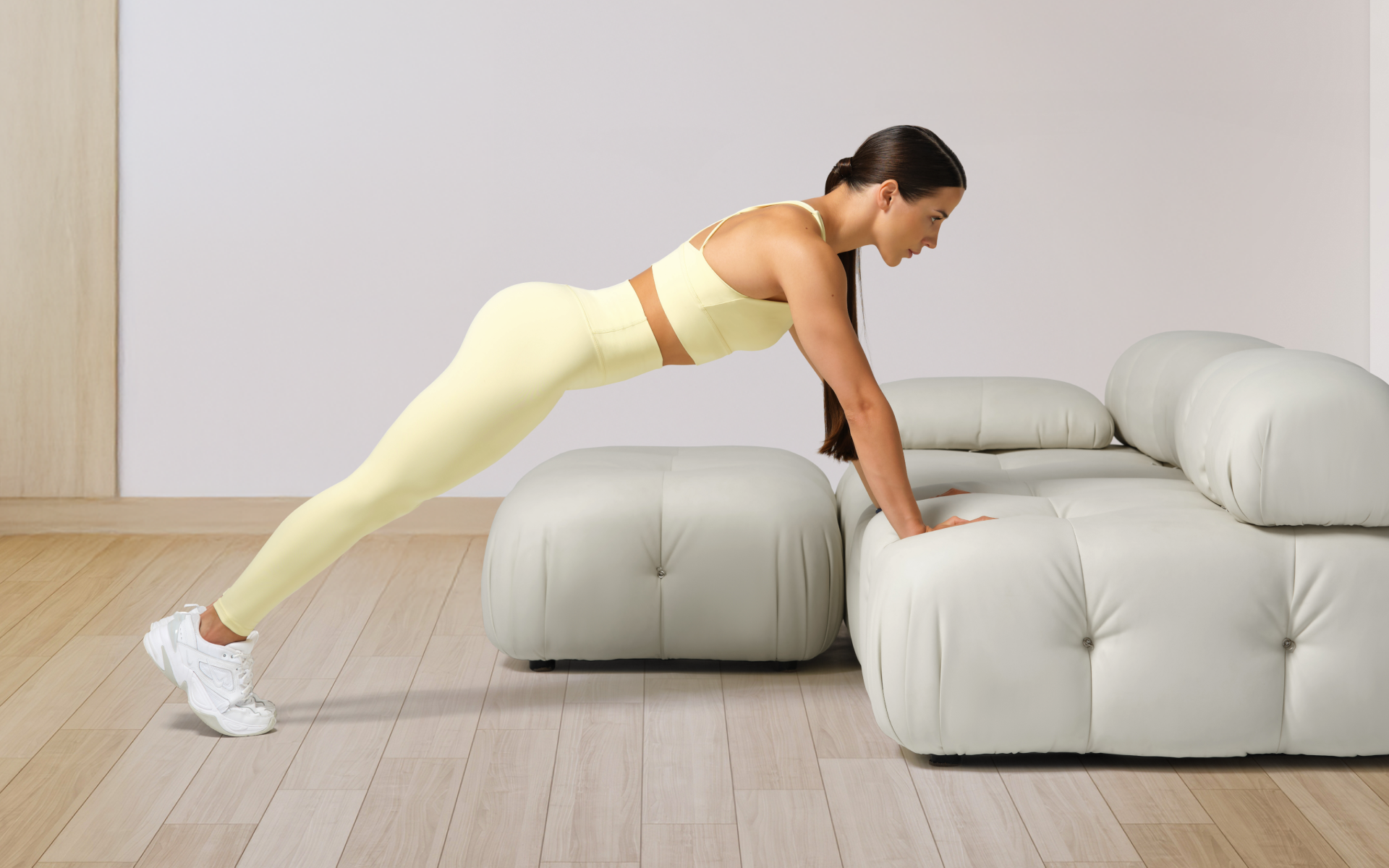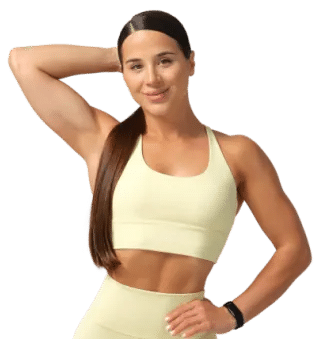Building an effective fitness routine at home can feel challenging. You might be wondering if you need a gym membership, a full rack of weights, or complex training splits to see real results. The good news is that science points toward a simpler, more efficient method: the total-body workout at home.
This guide is designed to cut through the noise.
We’ll explore the evidence behind why full-body training is so effective, particularly for those who are training at home with limited equipment. You’ll learn how to structure your workouts, which exercises provide the most benefit, and how to progress safely to achieve your strength and body composition goals.
We’ll break down the following key areas:
- The scientific comparison between full-body and split-body routines.
- How to create an effective home workout environment.
- A clear starting plan for beginners.
- The essential exercises that form the foundation of a total-body workout.
- The optimal frequency for your training week.
Let’s dive into the research and build a plan that works for you.
Are Full-Body Workouts Better Than Splits?
When deciding between full-body and split routines, it’s important to recognize that both can be effective and the “best” option isn’t universal. Your choice should reflect your goals, training experience, and personal preference. Below, we’ll break down the research and real-world outcomes for fat loss and muscle growth.
Full-Body vs Split: Fat Loss
Recent research – including a 2024 controlled study – has suggested that full-body routines performed frequently throughout the week can result in slightly greater fat mass reduction compared to split-body routines, at least in the short term and among well-trained individuals (1).
However, it’s important to consider the limitations: this study involved five full-body sessions per week (a frequency higher than most people realistically maintain), and measured fat mass but not fat-free mass (muscle gain).
In real-world settings, fat loss is driven primarily by nutrition and overall weekly activity rather than your exact training split (2). Regardless of format, weight training supports the preservation of muscle while you’re losing fat, and contributes to overall calorie expenditure (3). Full-body routines may encourage additional energy expenditure (EPOC) across more days (4), but this effect is modest in comparison to the calories that are burned through day-to-day movement and dietary choices.
Another consideration is that the “split” routine in the referenced study used an atypical set-up – performing very high volume for individual muscle groups in a single session, which isn’t representative of most evidence-based split programs. This design led to unusually high muscle soreness (DOMS), potentially reducing general activity outside the gym (1). Balanced split routines in real training rarely focus so much volume on one muscle group per day and are structured to avoid excessive soreness.
Full-Body vs Split: Muscle Growth
Building muscle (hypertrophy) is dependent on consistently applying progressive overload, accumulating adequate weekly training volume, and balancing recovery – factors that can be accomplished with either full-body or split-style training.
While the aforementioned study did not measure muscle gain, other research consistently finds that, when total weekly volume is the same, full-body and split routines produce comparable increases in muscle mass and strength for most people (5).
Full-body workouts typically allow for higher training frequency (stimulating muscles multiple times per week) (6). This can be particularly advantageous for beginners, busy professionals, or those who are training at home with limited time, as it’s easier to spread the volume across several shorter sessions (7). For more advanced lifters aiming to maximize specific muscle development, split routines allow for more targeted work per muscle group (8).
Importantly, neither approach is inherently “better”. The best program is one that keeps you consistent, matches your recovery capacity, and maintains your enthusiasm for training. If a full-body routine suits your lifestyle, or if you enjoy focused split sessions, both can support your muscle-building and fitness goals when applied with a structured, evidence-based approach.
Ready to take on a structured plan? Explore our 30-day full-body challenge.
Read more: 8-Week Workout Plan for Females to Build Muscle and Lose Fat
Can You Do Total-Body Workouts at Home?
Absolutely. One of the greatest advantages of total-body workouts is their adaptability. You can achieve fantastic results from the comfort of your own home, regardless of how much equipment you have. The principles of effective training – progressive overload, consistency, and proper form – are universal and can be applied anywhere.
Total-Body Workout at Home Without Equipment
You do not need a gym to build a strong, functional body. Your own body weight is a powerful tool for resistance training. By manipulating leverage, tempo, and exercise variations, you can create a challenging workout that stimulates muscle growth and improves strength (9).
For example, a standard push-up can be made easier by performing it on your knees or against a wall. To make it harder, you can:
- Elevate your feet
- Slow down the lowering phase of the movement (the eccentric portion)
- Progress to more advanced variations such as pike push-ups or one-arm push-ups (10)
This is the principle of progressive overload in action. A full-body workout at home without equipment male or female can be built entirely on these progressions.
Total-Body Workout at Home with Weights
If you have access to some basic equipment, such as dumbbells, kettlebells, or resistance bands, you can expand your exercise library and add load more directly. A total-body workout at home with weights allows for more precise increases in resistance, which is a key driver of long-term strength and muscle gains (11).
Even a single pair of dumbbells can unlock hundreds of exercises. You can use them for:
- Goblet squats
- Romanian deadlifts
- Overhead presses
- Bent-over rows
- Lunges
These will cover all the fundamental human movement patterns.
Resistance bands are another excellent, space-saving option for adding resistance to exercises such as rows, presses, and squats.
The key is to focus on compound exercises – movements that work multiple muscle groups across multiple joints simultaneously. These exercises give you the most “bang for your buck”, which makes your workouts efficient and highly effective.
Reasons why BetterMe is a safe bet: a wide range of calorie-blasting workouts, finger-licking recipes, 24/7 support, challenges that’ll keep you on your best game, and that just scratches the surface! Start using our app and watch the magic happen.
How Can Beginners Start a Total-Body Workout at Home?
Starting a new fitness routine can be intimidating, but a structured approach makes it manageable and effective. For a total-body workout at home for beginners, the focus should be on three things: consistency, mastering form, and listening to your body.
Here’s a simple framework to get you started.
- Establish a Schedule: Consistency is more important than intensity when you’re starting. Aim for 2-3 workouts per week on non-consecutive days (e.g. Monday, Wednesday, Friday). This frequency is sufficient to stimulate adaptation while allowing your body adequate time to recover (12).
A 30-minute workout at home for beginners is a perfect starting point.
- Focus on Movement Patterns, Not Muscles: Instead of thinking about training “chest” or “legs”, think in terms of fundamental human movement patterns. A well-rounded total-body workout should include:
- Squat: A lower-body knee-dominant movement (e.g. bodyweight squat, goblet squat).
- Hinge: A lower-body hip-dominant movement (e.g. glute bridge, Romanian deadlift).
- Push: An upper-body pushing movement (e.g. push-up, dumbbell press).
- Pull: An upper-body pulling movement (e.g. dumbbell row, inverted row).
- Core: Exercises that train your core to resist movement (e.g. plank, dead bug).
- Prioritize Form Over Weight or Reps: Before you add weight or try to do more repetitions, your number one priority should be learning how to perform each exercise with perfect technique.
Poor form not only increases your risk of injury but also reduces the effectiveness of the exercise (13). Film yourself with your phone to check your form against reliable video tutorials.
- Use Perceived Exertion to Guide Intensity: As a beginner, you don’t need to train to failure. Use the rate of perceived exertion (RPE) scale, a 1-10 scale where 1 is resting and 10 is maximal effort (14).
Aim for an RPE of 7-8 for most of your sets when you first start. This means the set feels challenging, but you could have done a few more reps if you had to. This is often described as leaving 2-3 reps in reserve (RIR) (15).
A full-body workout at home for beginners can be as simple as selecting one exercise from each movement pattern and performing 2-3 sets of 8-12 repetitions for each. This will create a balanced, efficient, and effective workout that builds a solid foundation for future progress.
What Key Exercises Should a Total-Body Workout at Home Include?
A highly effective total-body workout is built on a foundation of compound exercises that target the primary human movement patterns. Below is a 4-week progressive program designed to be completed 3-5 times per week. Each session should take approximately 30-45 minutes.
This program includes options for those with no equipment and for those with basic weights (dumbbells, kettlebells, or a loaded backpack).
Key Terms:
- Sets: The number of rounds you perform for each exercise.
- Reps: The number of repetitions (one complete motion) you perform in each set.
- Rest: The time you rest between sets.
- RPE (rate of perceived exertion): How hard the set feels on a scale of 1-10.
- Tempo (e.g. 3-1-1-0): The speed of the movement.
- First number (3): Eccentric (lowering) phase in seconds.
- Second number (1): Pause at the bottom in seconds.
- Third number (1): Concentric (lifting) phase in seconds.
- Fourth number (0): Pause at the top in seconds.
| Week | Movement pattern | Exercise examples (choose one) | Sets | Reps | Rest (sec) | RPE | Tempo |
|---|---|---|---|---|---|---|---|
| Week 1: Foundation | Squat (knee dominant) | Bodyweight squat, goblet squat | 3 | 8-10 | 60-90 | 6-7 | 3-1-1-0 |
| Hinge (hip dominant) | Glute bridge, Romanian deadlift (RDL) | 3 | 10-12 | 60-90 | 6-7 | 2-1-1-1 | |
| Push (horizontal) | Incline push-up (on stairs/bench), dumbbell floor press | 3 | 8-10 | 60-90 | 6-7 | 3-1-1-0 | |
| Pull (horizontal) | Inverted row (under a sturdy table), single-arm dumbbell row | 3 | 8-10/arm | 60-90 | 6-7 | 2-1-1-1 | |
| Core (anti-extension) | Plank | 3 | 30-45 sec | 60 | 7 | - | |
| Week 2: Progression | Squat | Bodyweight squat, goblet squat | 3 | 10-12 | 60 | 7-8 | 3-1-1-0 |
| Hinge | Single-leg glute bridge, RDL | 3 | 12-15 | 60 | 7-8 | 2-1-1-1 | |
| Push | Push-up (from knees or toes), dumbbell floor press | 3 | As Many Reps As Possible (AMRAP) | 60 | 8 | 2-1-1-0 | |
| Pull | Inverted row, single-arm dumbbell row | 3 | 10-12/arm | 60 | 7-8 | 2-1-1-1 | |
| Core (anti-rotation) | Bird-dog | 3 | 10/side | 60 | 7 | Slow and controlled | |
| Week 3: Overload | Lunge (unilateral) | Bodyweight reverse lunge, dumbbell reverse lunge | 3 | 8-10 /leg | 60 | 7-8 | 2-1-1-0 |
| Hip thrust | Bodyweight hip thrust, single-leg hip thrust | 3 | 12-15 | 60 | 7-8 | 1-1-1-2 | |
| Push (vertical) | Pike push-up, dumbbell overhead press | 3 | 8-10 | 60 | 7-8 | 2-1-1-0 | |
| Pull | Inverted row, single-arm dumbbell row | 4 | 8-10/arm | 60 | 8 | 2-1-1-1 | |
| Carry (bracing) | Farmer's carry (with weights), suitcase carry (one-sided) | 3 | 30m/set | 60 | 8 | - | |
| Week 4: Intensity | Squat | Pause squat (3 sec pause at bottom), goblet squat | 4 | 8-10 | 45-60 | 8-9 | 3-3-1-0 |
| Hinge | Single-leg RDL (bodyweight or with light weight) | 3 | 8-10/leg | 45-60 | 8-9 | 3-1-1-0 | |
| Push | Decline push-up, dumbbell bench press | 4 | AMRAP | 45-60 | 9 | 2-1-1-0 | |
| Pull (vertical) | Chin-up/pull-up (or band-assisted), band pull-apart | 4 | AMRAP | 45-60 | 9 | 2-1-1-0 | |
| Core (anti-rotation) | Pallof press (with resistance band) | 3 | 10-12 /side | 45 | 8 | 2-2-1-0 |
Exercise Execution Guide
Proper form is non-negotiable. Here’s a step-by-step guide for each key exercise.
- Squat (Goblet Squat)
- Stand with your feet slightly wider than shoulder-width apart and your toes pointed slightly outward. Hold a dumbbell or kettlebell vertically against your chest with both hands.
- Brace your core by taking a deep breath and tightening your abdominal muscles, as if preparing for a punch.
- Initiate the movement by pushing your hips back and then bending your knees. Keep your chest up and your back straight.
- Lower yourself until your thighs are parallel to the floor or as low as you can comfortably go while maintaining a neutral spine.
- Drive through your midfoot to stand back up, squeezing your glutes at the top.
Common Error: Knees caving inward.
Correction: Actively push your knees out during the movement. Imagine trying to spread the floor apart with your feet.
- Hinge (Romanian Deadlift – RDL)
- Stand with your feet hip-width apart, holding a dumbbell in each hand in front of your thighs, with your palms facing you.
- Maintain a slight bend in your knees throughout – don’t treat this as a squat.
- Push your hips straight back while keeping your spine long and your chest up.
- Lower the weights until you feel a deep stretch in your hamstrings, typically just below the knees.
- Drive your hips forward to return to standing, squeezing your glutes at the top.
Common Error: Rounding the lower back.
Correction: Keep your shoulder blades back and lower only as far as you can maintain a flat back.
- Single-Leg RDL
- Stand tall with your feet hip-width apart, holding a weight (if using) in one hand.
- Shift your weight onto one leg and soften your knee.
- Hinge at the hips, extending your free leg back behind you as your torso leans forward.
- Lower the weight (or touch) toward your standing foot while keeping your hips and shoulders square.
- Return to the starting position by driving your hips forward and bringing your free leg back in.
- Complete repetitions, then switch legs.
Common Error: Hips opening up or rotating.
Correction: Keep both hip bones facing the floor the entire time.
- Lunge (Reverse Lunge)
- Stand with your feet together and brace your core.
- Step backward with your right foot, landing softly on the ball of your foot.
- Lower your hips until both knees are at 90 degrees, your front shin vertical and your back knee hovering just above the ground.
- Push off your back foot to return to standing.
- Complete all reps on one leg, then switch.
Common Error: The front knee travels too far past your toes.
Correction: Take a bigger step back and drop your hips straight down.
- Glute Bridge / Hip Thrust
- Lie on your back with your knees bent and your feet flat, hip-width apart. For hip thrusts, place your upper back on a bench or couch.
- Brace your core and drive through your heels to lift your hips up until your shoulders, hips, and knees form a straight line.
- Pause and squeeze your glutes at the top for 1–2 seconds.
- Lower hips back down in a controlled way.
Common Error: Hyperextending the lower back at the top.
Correction: Keep your ribs down and your core braced – think “straight line” from shoulders to knees.
- Push-Up (Incline, Decline, Standard)
- Start in a plank: your hands shoulder-width apart and your body in a straight line from head to heels.
- Brace your core and squeeze your glutes.
- Bend your elbows to lower your chest to within a few inches of the floor, keeping your elbows at roughly 45 degrees from your torso.
- Press back to the starting position powerfully.
Common Error: Hips sagging or piking.
Correction: Maintain body tension, keeping your torso and legs as one plank.
BetterMe: Health Coaching app helps you achieve your body goals with ease and efficiency by helping to choose proper meal plans and effective workouts. Start using our app and you will see good results in a short time.
- Pike Push-Up
- Begin in a push-up position, then walk your feet in so your hips are elevated, forming an inverted “V.”
- Look at your feet and keep your elbows tucked.
- Bend your elbows and lower the crown of your head toward the floor, keeping your hips high.
- Press through your hands to return to start.
Common Error: Letting the elbows flare wide or lowering the forehead instead of the top of the head.
Correction: Keep your elbows tucked and your hips high throughout.
- Dumbbell Overhead Press
- Stand or sit with your core braced, weights at shoulder height, your palms forward.
- Press both weights directly overhead, keeping your biceps beside your ears.
- Pause momentarily at the top, then lower under control.
Common Error: Excess arching in the lower back.
Correction: Squeeze your glutes and abs, stacking your ribs over your pelvis.
Read more: Dumbbell Only Workout Plan: Build A Big Back Without A Gym
- Inverted Row
- Set a secure bar, sturdy table, or suspension trainer at waist height.
- Lie underneath, grip the bar with your hands shoulder-width apart, your heels on the floor, and your body in a straight line.
- Brace your core and pull your chest toward the bar by squeezing your shoulder blades together.
- Lower your body with control to the starting position.
Common Error: Flaring elbows or shrugging shoulders.
Correction: Keep your elbows close and squeeze your shoulder blades down and together.
- Single-Arm Dumbbell Row
- Place one knee and hand on a bench, your torso parallel to the floor.
- Hold a dumbbell in your free hand with your arm extended.
- Pull your shoulder blade back, then drive your elbow toward your hip, bringing the dumbbell to your ribcage.
- Lower with control. Complete all reps before switching.
Common Error: Twisting the torso or using momentum.
Correction: Engage your core and keep your torso still.
- Pull-Up / Chin-Up
- Grip the bar with your hands slightly wider than shoulder-width apart (pull-up, palms away; chin-up, palms toward you).
- Hang with your arms fully extended and your shoulders engaged (slight active hang).
- Pull your chest toward the bar by driving your elbows down and back.
- Clear your chin above the bar, then lower with control to full arm extension.
Common Error: Using momentum or kipping, incomplete range.
Correction: Pull with your back, avoid swinging, and use a full range of motion.
- Band-Assisted Pull-Up / Band Pull-Apart
- Band-Assisted Pull-Up:
- Loop a band over the bar, place your foot/knee in the loop for assistance, and perform a pull-up as above, focusing on controlled motion.
- Band Pull-Apart:
- Hold a resistance band at shoulder height with your arms straight.
- Pull the band apart by moving your arms out to the sides, squeezing your shoulder blades together.
- Return to start with full control.
Common Error: Using momentum or incomplete squeeze.
Correction: Move slowly, finish with your shoulder blades pinched.
- Farmer’s Carry / Suitcase Carry
- Pick up a heavy weight in each hand (farmer’s) or one hand (suitcase).
- Stand tall with your shoulders back and your core braced and walk forward, resisting any side-bending.
- Walk the designated distance or time – switch hands for suitcase carry.
Common Error: Leaning to one side or having a rounded posture.
Correction: Maintain an upright posture and engage your obliques.
- Plank
- Place your elbows under your shoulders, your legs extended and your feet together.
- Brace your core, glutes, and quads to form a straight line from your head to your heels.
- Hold the position while breathing steadily.
Common Error: Hips sagging or lifting.
Correction: Maintain tension and alignment throughout the set.
- Pallof Press (Anti-Rotation Core)
- Attach a resistance band to a sturdy anchor at chest height.
- Stand perpendicular to the anchor, your feet hip-width apart, and hold the band handle with both hands at your chest.
- Step away to create tension, then extend your arms straight in front of your chest.
- Hold for a second, resisting any twist, then return your hands to your chest.
- Complete all reps before switching sides.
Common Error: Allowing the body to rotate or the hips to shift.
Correction: Brace your core hard and imagine “zipping up” your abs.
- Bird-Dog
- Start on all fours with your hands under your shoulders and your knees under your hips.
- Extend your right arm forward and your left leg back, keeping your hips and shoulders squared.
- Pause, then return to start and alternate sides.
Common Error: Letting the hips rotate or arching the back.
Correction: Move slowly, keeping your hips and shoulders level.
For a deeper dive into foundational movements, learn more about Core Structural Exercises.
How Often Should You Do a Total-Body Home Workout?
The optimal training frequency will depend on your goals, recovery capacity, and schedule. However, for a total-body workout, research and practical application point to a sweet spot.
For most individuals, training 2 to 3 days per week is ideal. This frequency allows you to accumulate sufficient weekly training volume to stimulate muscle growth and strength gains without overtaxing your recovery systems (12).
A schedule such as Monday, Wednesday, and Friday provides a day of rest between each session, which is essential for muscle repair and adaptation.
Find the perfect weekly schedule for you with this 4-Day Full-Body Workout plan.
While no single exercise works every muscle in the body optimally, some are incredibly comprehensive. The barbell clean and jerk, the snatch, and the Turkish get-up come close, as they’re dynamic, multi-joint movements that demand strength, stability, and coordination from head to toe. However, a balanced routine will always be superior to relying on a single lift. Yes, absolutely. Getting “ripped” requires two things: building a solid base of muscle and reducing body fat to make that muscle visible. As demonstrated by recent research, full-body workouts are highly effective for fat loss (1). They’re also excellent for building muscle, provided you apply the principle of progressive overload by consistently increasing the challenge over time (6). A 20-minute full-body workout can be very effective, particularly if it’s done consistently and with high intensity. The key is to be efficient. Use compound exercises, minimize rest periods (e.g. by using circuits or supersets), and push yourself to a high RPE. While a longer workout may allow for more total volume, a well-structured 20-minute session performed 4-5 times per week can produce significant results. It isn’t recommended to perform intense full-body resistance training every single day. Your muscles need time to recover and adapt – recovery is when growth actually happens (16). Training the same muscles with high intensity daily can lead to overtraining, increased injury risk, and diminished returns. A schedule of 3-5 days per week with rest days in between is a more sustainable and effective approach (12).Frequently Asked Questions
Is there a single exercise that works the whole body?
Can you get ripped with full-body workouts?
Is a 20-minute full-body workout effective?
Can I do full-body every day?
The Bottom Line
The evidence is clear: total-body workouts are a powerful, efficient, and highly adaptable method for improving your strength and body composition. By focusing on compound movements, managing your recovery, and applying the principle of progressive overload, you can build a formidable physique in the comfort of your own home.
You don’t need fancy equipment or complicated routines – just a smart plan and the consistency to execute it. Start with the foundations, master the movements, and embrace the process of becoming stronger, healthier, and more resilient.
DISCLAIMER:
This article is intended for general informational purposes only and does not serve to address individual circumstances. It is not a substitute for professional advice or help and should not be relied on for making any kind of decision-making. Any action taken as a direct or indirect result of the information in this article is entirely at your own risk and is your sole responsibility.
BetterMe, its content staff, and its medical advisors accept no responsibility for inaccuracies, errors, misstatements, inconsistencies, or omissions and specifically disclaim any liability, loss or risk, personal, professional or otherwise, which may be incurred as a consequence, directly or indirectly, of the use and/or application of any content.
You should always seek the advice of your physician or other qualified health provider with any questions you may have regarding a medical condition or your specific situation. Never disregard professional medical advice or delay seeking it because of BetterMe content. If you suspect or think you may have a medical emergency, call your doctor.
SOURCES:
- Full-body resistance training promotes greater fat mass loss than a split-body routine in well-trained males: A randomized trial (2024, onlinelibrary.wiley.com)
- Physiological process of fat loss (2019, researchgate.net)
- Effect of resistance exercise on body composition, muscle strength and cardiometabolic health during dietary weight loss in people living with overweight or obesity: a systematic review and meta-analysis (2025, bmjopensem.bmj.com)
- 7 Things to Know About Excess Post-exercise Oxygen Consumption (EPOC) (2014, acefitness.org)
- Efficacy of Split Versus Full-Body Resistance Training on Strength and Muscle Growth: A Systematic Review With Meta-Analysis (2024, pubmed.ncbi.nlm.nih.gov)
- 5 Benefits of Compound Exercises (2016, acefitness.org)
- No Time to Lift? Designing Time-Efficient Training Programs for Strength and Hypertrophy: A Narrative Review (2021, link.springer.com)
- Training Programs Designed for Muscle Hypertrophy in Bodybuilders: A Narrative Review (2020, mdpi.com)
- Benefits of Bodyweight Training (2025, humankinetics.me)
- Kinetic Analysis of Several Variations of Push-Ups (2011, journals.lww.com)
- Effects of Resistance Training Overload Progression Protocols on Strength and Muscle Mass (2024, pubmed.ncbi.nlm.nih.gov)
- Effects of Resistance Training Frequency on Measures of Muscle Hypertrophy: A Systematic Review and Meta-Analysis (2016, link.springer.com)
- HOW POOR WEIGHTLIFTING FORM LEADS TO INJURY (n.d., integrehab.com)
- THE RATE OF PERCEIVED EXERTION (RPE) SCALE EXPLAINED (n.d., nasm.org)
- REPS IN RESERVE (RIR): WHAT YOU NEED TO KNOW (n.d., nasm.org)
- The Importance of Recovery in Resistance Training Microcycle Construction (2024, pmc.ncbi.nlm.nih.gov)
